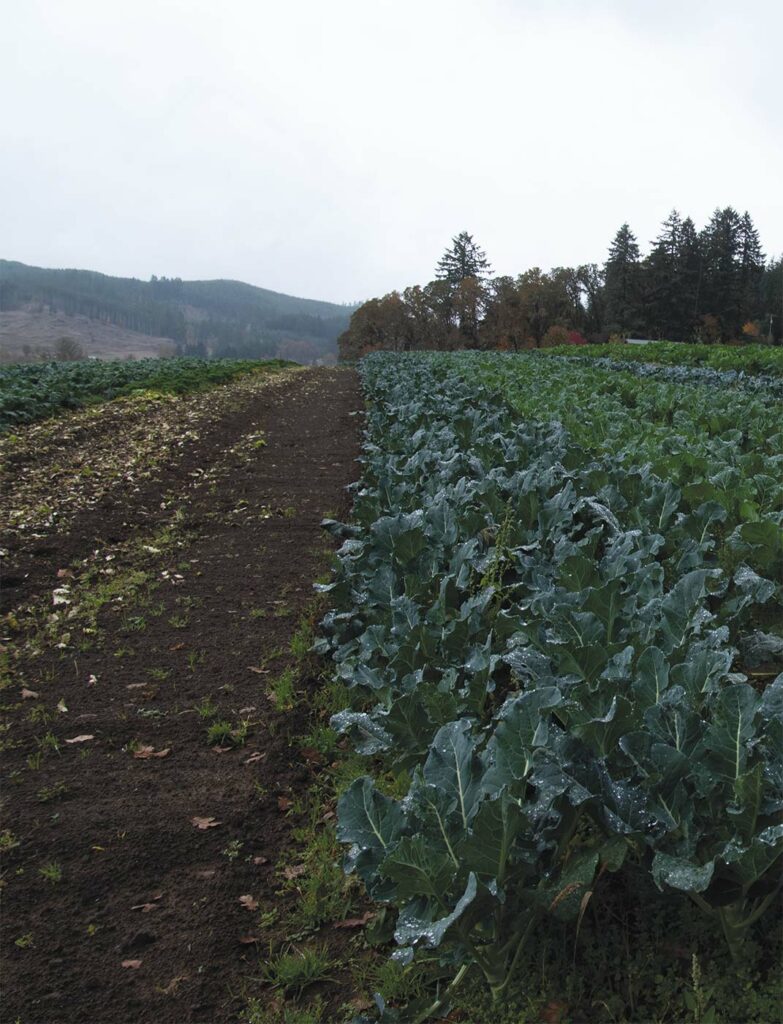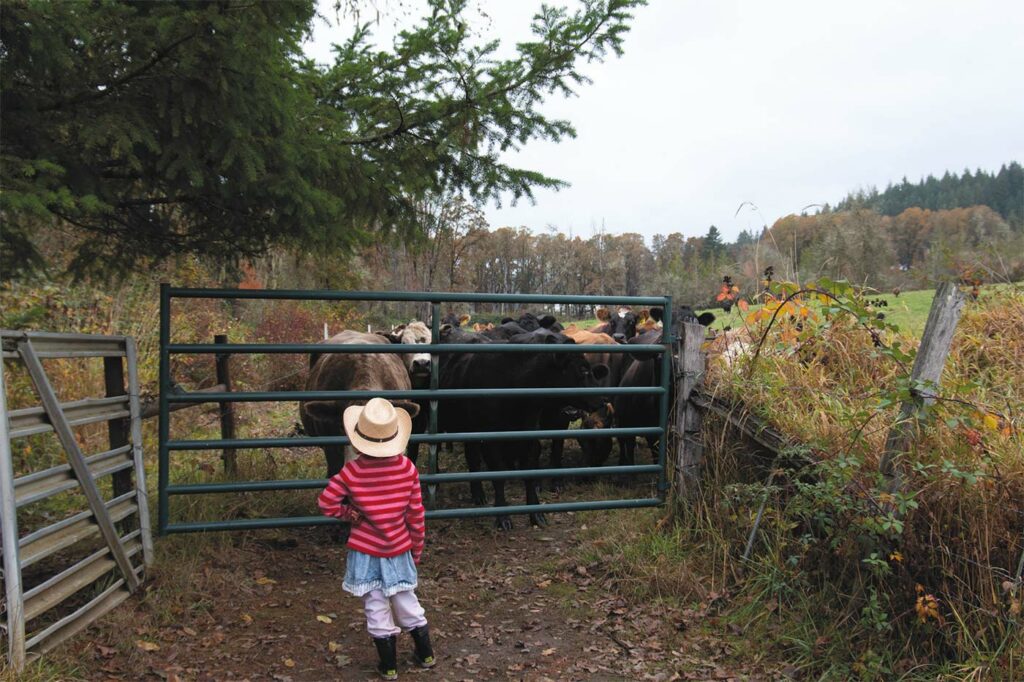
Winter eco-gastronomy embarks on a delightful journey of seasonal, sustainable dining that aligns with ecological principles while highlighting the rich flavors of organic meats and hearty winter vegetables. Winter Green Farm in Noti, Oregon, is a biodynamic farm offering beef, lamb, strawberries and vegetables. Owner Chris Overbaugh, his wife Shannon, their sons Porter and Alden, along with Cattle Manager Kevin Melia and his family, engage in essential tasks during the winter to uphold their biodynamic practices.
THE ORIGINS OF WINTER GREEN FARM
In 1980, Jack Gray and Mary Jo Wade founded the farm with the hope and vision of producing healthy food for themselves and their community. In 1986, Wali and Jabrila Via came to the farm. Wali is a prominent figure in biodynamic farming. Although he is now retired, he continues to host several workshops on biodynamic preparation-making, fostering a strong community connection. Today, Chris, Kevin, and their families run the 171-acre farm with a focus on community engagement and giving back by donating produce to local food banks. They strive to cultivate a respectful and educational work environment, emphasizing the health of the soil as essential to overall farm health.
The farm consists of several parts: produce takes up about 25 acres, and 90 acres are dedicated to pasture and hay for the sheep and cattle. Wetlands, riparian areas and oak groves make up the remaining acreage.
Produce and meat from the farm is sold through several venues: three farmers’ markets, a farm stand, the farm’s CSA with 375 members, Natural Food Stores, Food for Lane County, School Districts in Eugene, local restaurants, the Organically Grown Company, a few produce markets in Portland and to the general public via their website.
THE MISSION OF WINTER GREEN FARM
Chris said, “Our mission is to operate a productive farm in harmony with the earth, humanity, and ourselves.” To Chris, this means:Making soil health a priority through careful tillage, composting, and cover cropping.
Ensuring that everyone has access to quality food while treating workers fairly and providing a respectful work culture.
“Our mission is to operate a productive farm in harmony with the earth, humanity, and ourselves.” – Chris Overbaugh, Winter Green Farm
INSIGHTS FROM KEVIN
A big part of biodynamic farming is creating fertility and, subsequently, organic compost. This practice begins in the winter. For Kevin, winter starts when it is “too wet,” according to his definition, in the fall and ends when it is “dry enough” in the spring. The cattle stay in the barn during Kevin’s definition of winter. To be classified as organic, they are limited to 120 consecutive days in the barn, which means carefully balancing when winter begins and ends is vital for organic classification and pasture management.
WINTER PRACTICES
Keeping the barn clean requires deep bedding practices that maintain hygiene while capturing fertility that will later enrich the fields. Fresh organic hay is added on top of the manure three times per week. At the end of winter, the fertility in the barn is collected to create a nutrient-rich compost to spread on the pastures and gardens later in the year.
Keeping the cattle in the barn also balances the grazing time, ensuring that they do not overgraze. Overgrazing in agriculture occurs when animals consume plants faster than they can regenerate, leading to a decline in plant numbers and soil health. Although Kevin would prefer to keep cattle on grass all year, housing them in the barn can create excellent compost and give the pastures time to recover during the extended wet periods.
BASIL HELPS ON THE FARM
Like rotating produce crops, the cattle are moved frequently to prevent overgrazing and give them the most nutrient-rich grass while they are out in the pastures. The farm produces certified organic beef and certified organic hay. Kevin and his daughter Basil set up new lines before moving the cattle to a new section of pasture every 12 to 72 hours. It was a pleasure to watch and listen to Basil call out to bring the cattle into “greener pastures.” Her singsong chant, “Come on cows, come on cows,” was a delight.
These well-cared-for, docile creatures came running toward her, and after they were all gathered at the gate, Kevin would open it, and he and Basil would lead the herd into the next pasture. It was obvious that the cattle knew their masters and were quite comfortable with them.

CATTLE AT WINTER GREEN FARM
Winter Green Farm’s cattle are primarily Angus bulls and Jersey cows. Jersey breeds are known for their higher fat content and smaller size, which makes a gentler impact on the pastures. Therefore, the calves raised on the farm are mostly a mix of Angus and Jersey breeds. Kevin harvests the beef at 18 to 24 months for optimal fat and marbling.
Although many people are looking for lean meat, Kevin understands that there is another market for delicious, organic, well-marbled beef.
Kevin sent me a few steaks to sample. The beef was delicious, lightly seasoned with just salt and pepper. It was juicy, tender, and certainly worth buying.
PERSPECTIVES FROM CHRIS
Chris said, “Our farm is an organism where the farmer, cattle, and sheep play crucial roles. We aim for a closed-loop system, relying on our animals for fertility. We use cattle manure bedding in our compost and produce all the compost necessary to fertilize our fields, complementing it with cover crops and minimal mineral management.”
The 30 ewes produce lamb that is available for sale, and the gardens on the farm boast more than 40 vegetable varieties from arugula to zucchini. Typically, Winter Green Farm produce is harvested just a day before selling; this ensures fresher produce
than traditional stores that often sell older, long-traveled goods.
Chris believes that Biodynamic Farming makes him a more mindful
farmer.

PEST MANAGEMENT AND CROP ROTATION
Healthy soil leads to healthy plants. Since 1986, the farm has been employing a six-year crop rotation system for farming biodynamically. This method allows for rejuvenation of the land and disrupts pest cycles. Winter vegetables like lettuce, kale, and cabbage thrive despite cold temperatures.
Winter Green Farm invites the public to join their CSA to receive fresh, delectable produce for 19 to 24 weeks throughout the summer, purchase their delicious lamb and buy beef by the quarter, half or whole from their website at https://wintergreenfarm.com/
Incorporating eco-gastronomy into your winter meals is a way to nourish both the body and the planet. It is all about creating a deeper connection to the food you are eating and honoring the rhythms of nature while making mindful choices for sustainability.
By purchasing products from Winter Green Farm and putting the above ideas into practice, you can enjoy winter’s bounty while simultaneously supporting the local farms in your community.
CONSIDERATIONS FOR SUPPORTING ECO-GASTRONOMY IN THE WINTER
Maintain Regional and Seasonal Awareness: Be aware of what is in season in your region.
Support the Local Producers: Purchasing ingredients from local farmers, markets, or cooperatives helps reduce the carbon footprint of your meals and supports sustainable agriculture.
Preserve Nutrients and Flavor: Winter foods often require slower cooking techniques like braising, roasting, or slow simmering, which helps maintain the ingredients’ nutrients and flavors.
Use Energy Efficiency Cooking Methods: Consider cooking methods that use less energy, like pressure cookers or slow cookers, which are great for winter dishes like stews and soups.
IDEAS FOR A TASTY APPROACH TO ECO-GASTRONOMY IN THE WINTER
Embrace Root Vegetables and Hearty Greens: Winter is the time for carrots, parsnips, turnips, beets and potatoes. These vegetables store well through colder months and provide a deep, earthy flavor profile. Similarly, hearty greens like kale, collard greens and Brussels sprouts thrive in the winter and contain loads of nutrients.
Incorporate Winter Fruits: Though winter fruits may seem limited, many varieties of apples, pears and citrus are in season and can provide a refreshing contrast to the heavier root vegetables. Focus on Sustainable Protein Sources: In winter, hearty dishes featuring plant-based proteins (like beans, lentils, and peas) and locally raised, sustainably sourced meats (purchased at Winter Green Farms) are a fantastic way to eat ecologically. winter is also the season for wild game, like venison, rabbit or pheasant, if ethically sourced in the wild or through regenerative farming systems.
Serve Fermented and Preserved Foods: Enjoy fermented foods and preserves, which help make the most of the harvest and support gut health. Think of krauts, kimchi, pickles, and fermented dairy products.
Utilize Grains and Legumes: Slow-cooked grains and legumes are warming and nourishing. Barley, oats, quinoa, farro and spelt taste fabulous and provide excellent fiber and protein. Forage: If you know what to look for, consider foraging for wild edibles such as mushrooms, winter greens (like dandelion), and nuts. If you are unsure, bring a professional.
Include Local and Ethical Dairy and Cheese: Rich dairy products like cheese, butter, and cream, especially those produced from local farms using regenerative practices, will add flavor to your meals.
Prepare Hearty Soups and Stews: When it is cold, slow-cooked stews, broths, and soups made using local seasonal ingredients will warm you from the inside out.
Create Easy Meals: Eco-gastronomy promotes zero-waste cooking because many foods are stored and preserved for extended periods. Be creative with leftovers. Use vegetable scraps, bones, and lesser cuts of meat to create broths and stocks for future meals.
Incorporate Thoughtful Pairings with Winter Beverages: Pairing meals with local, seasonal beverages—such as winter ales, hot apple cider, herbal teas, and mulled wine—can complement the flavors of your dishes.

